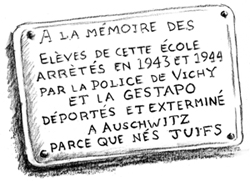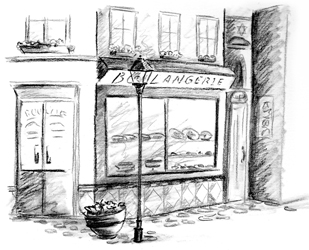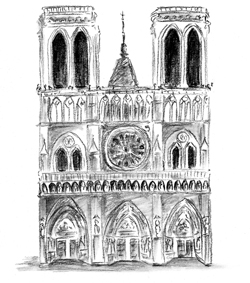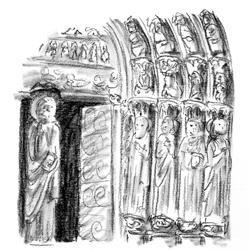Mira's Diary (2 page)
Authors: Marissa Moss


It felt strange to be traveling without Mom, being on a huge plane, landing in a foreign country, having my new passport stamped for the very first time. I was so excited to see the billboards in French as we drove from the airport into the city, and then we were there, breezing alongside the Seine in the morning sunshine, turning down small winding streets until the cab pulled up outside our hotel. We were in Paris, which was already extraordinary, so I guess it was normal that nothing was normal. This was our family checking into our hotelâjust me, Malcolm, and Dad.
I tried not to think about Mom, to think about Paris instead, noticing the art deco metro entrances, the woman walking down the street with a baguette under her arm, just like you would see in the movies, the total Frenchness of our hotel. Dad had chosen a charming, tiny hotel, in the Place Sainte-Catherine in the heart of the Marais. The beds took up most of the room, so we just dumped our suitcases, eager to be out in the streets, to soak up Paris. Dad slung his camera over his shoulder, Malcolm carried the city map, and I took my sketchbook, the small one I could tuck into my pocket.
Marais means “swamp” and during the Middle Ages, this whole area on the right bank of the Seine was a giant marsh. Since it was clearly the worst place to live in the city, it was also the Jewish ghetto. There were still little hole-in-the wall synagogues, bakeries that sold challah and skinny French-Jewish bagels, and plaques all over the place marking the spots where Jewish families were rounded up and shipped off to concentration camps during World War II.

I could see the plaques and bagels myself. The other stuff I learned from Malcolm. He reads constantly and his favorite subject is history. If history was the only topic on
Jeopardy
, Malcolm could go on the show and win a fortune. That's how much he knows.
Dad, on the other hand, is a read-the-guidebook-right-before-you-see-anything kind of guy. “This may have been a mosquito-ridden marsh centuries ago, but now it's a trendy neighborhood. Look at all these pricey boutiques!” He pointed out a chi-chi clothing store (which of course we did
not
go into) right next to a dingy orthodox synagogue that was smaller than Arinell's, the tiny joint that makes our favorite pizza back home in Berkeley. You could just squeeze a minyan inside, the ten men necessary for Jews to pray together. I couldn't imagine the bent-over men with wispy gray beards, dressed in their long black coats, walking into the brightly lit shop next door with blaring French rap music and neon mannequins strutting in the windows. Talk about a culture clash.

“It's a different kind of ghetto now is all, an upscale one,” Malcolm said. Totally wasted on him, I thought. Some guys actually cared about making a fashion statement, but not him. And to be honest, I wasn't much good at it either. I wear jeans and T-shirts as much as he does.
We were meandering around on our first day in Paris, just getting a feel for the city, but really I think we were all looking for Mom, expecting to see her every time we turned a corner.
Dad led the way across the Seine to an island in the middle of the broad river. French schoolchildren on a field trip, their voices high and piping, crowded the narrow street. I wondered where they were going but as the street opened onto a square, I could see what drew them, what had attracted tourists from around the world and throughout the centuries. Notre Dame Cathedral. The home of the gargoyle on Mom's postcard.

We live in California, a young state in a young country, so about the oldest thing you can see there, besides the ancient redwood groves, is Sutter's Fort near Sacramento, where gold was discovered in 1848. Notre Dame was built seven centuries before that! It's an enormous, broad-shouldered building with elegant arches and flying buttresses pulling it up to the sky. Dad was rightâit's truly a wonder of the world.
Beautiful sculptures of prophets and apostles line deep portals on either side of the three massive front doors. Arches over the doors are also filled with sculptures, stories from the Bible carved in stone. I stood gaping, trying to figure out what the stories were. For a second, I imagined Mom standing in this exact same spot, head tipped back, reading the stones, and I felt a pang. She might have been here. Maybe she still was.

Usually when you go into a building, it's lighter or darker, cooler or warmer than outdoors, but it's still part of the same world. Stepping into Notre Dame was like changing time zones or countries, crossing some magical border. A hush filled the cavernous, echoey space of the cathedral, despite all the voices of tourists murmuring and people praying, as if the sound was absorbed into the bones of the building itself.
Light streamed in from the windows like a physical presence, the kind of light you think you can reach out and touch. I couldn't resist running my fingers over the brilliant colors cast onto the floor by the stained glass. I felt like I could pick them up, collect them in my hands. The air itself felt still and chilled by the stone all around. The walls were stretched thin between the pillars that soared into a vault overhead, like the skin of a massive beast taut between its ribs.

“Come on,” Malcolm whispered. “Let's light a candle for Mom.”
“Why?” I asked, annoyed that he'd jarred me out of the peaceful rhythm of the cathedral. “She isn't dead, just gone.”
But the flickering flames of the long white candles mesmerized me. I wanted to light one for myself. I didn't have any euros yet, but I slipped some quarters into the slotted metal box, lit a candle from the flame of its brother, and impaled it on one of the metal spikes branching out in front of a side altar. I wondered how many people had done this same simple thing and what they'd prayed for. A good harvest, a healthy baby, a new cow? I knew Malcolm was praying for Mom to come back, but I wasn't sure I wanted that. Would I forgive her if she called us tomorrow, said she was sorry for leaving?
I stared into the flames, searching for what I really wanted. An answer. I prayed to know the truthâgood, bad, or ugly. I wanted to know why.
Dad found us standing there, his guidebook open in his hands.
“Lose the book,” I begged. “You're making us look like dumb tourists.”
“We are dumb tourists, and this book is useful. It says here that you can climb a tower to go out to a walkway above the roof where the gargoyles are lined up. Let's find the one from Mom's postcard.”
“You think Mom's waiting for us there?” Malcolm rolled his eyes. He's an expert eye-roller, believe me.
“Of course not! I like gargoyles, that's all.” Dad tucked the guidebook into the messenger bag slung over his shoulder. “And I'll speak to you in French so we won't seem like tourists.”
“You don't have to go that far,” I said. My French is pretty basic.
Bonjour
,
merci
, and
je
m'appelle Mira
. Dad's wasn't much better. Mom was fluent. But she wasn't here.
We went outside to join the line that snaked alongside the flank of the cathedral. The last time I'd been in a line like this was at Great America, waiting to get on the Ultimate Drop ride. Now I was climbing a narrow, twisting stairway in a Gothic tower but I was just as nervous, scared almost. It was stupid to think we'd find Mom next to some gargoyle. Or a hidden message. But I couldn't get rid of the feeling that we were closer to her, that something was about to happen that would change everything.
After the cramped darkness of the tower, it was a relief to be out on the walkway. The view was amazing. All Paris lay spread out before us, the Seine river, bridges crisscrossing it, the towers of the fortress-like Conciergerie where nobles were imprisoned during the French Revolution, the Eiffel Tower, Gothic spires and slate roofs. It looked like something from a Madeline book. I almost expected to see nuns leading two straight lines of little girls dressed in blue and white with black hats perched on their heads.
All along the walkway, stone monsters crouched. In most churches gargoyles were fancy gutters, covering the spouts that channeled rainwater away from the walls. In Notre Dame, the gargoyles were simply decoration. Dad suggested they might be there to protect the cathedral from evil spirits. To me, they looked like evil spirits themselves. Still, I couldn't resist drawing them.